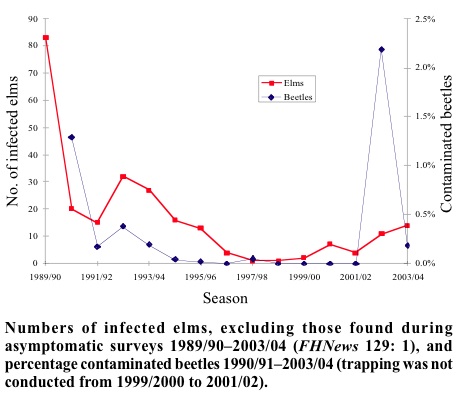PESTS AND DISEASES OF FORESTRY IN NEW ZEALAND
Dutch elm disease 2003/04
Scion is the leading provider of forest-related knowledge in New Zealand
Formerly known as the Forest Research Institute, Scion has been a leader in research relating to forest health for over 50 years. The Rotorua-based Crown Research Institute continues to provide science that will protect all forests from damage caused by insect pests, pathogens and weeds. The information presented below arises from these research activities.
From Forest Health News 138, March 2004.
The campaign to eradicate Dutch elm disease continues in Auckland. This summer there were two full disease detection surveys, one abbreviated survey, five special surveys, and a pheromone trapping programme. During the detection surveys, infected trees were found at 11 locations in Pakuranga, Papatoetoe, Western Springs, and Titirangi. A significant feature this season was that the infected trees were found at or near locations where diseased trees had been detected in previous years. The special surveys resulted in several new trees being added to the elm database and, in addition, elm firewood was discovered and destroyed before it became a potential source of infective beetles.
Initially 90 pheromone traps were deployed in high-risk areas, but this was increased to 100 as diseased trees were located during the first survey. In February, the Ministry of Agriculture and Forestry (MAF) initiated and funded a greatly increased trapping array and by 16 February a total of 206 traps were being checked weekly. By 9 March a total of 6445 beetles had been caught, of which only 10 (0.16%) were contaminated by the Dutch elm disease fungus, Ophiostoma novo-ulmi. Infective beetles were trapped at Birkenhead in the North Shore, central Auckland, east Tamaki, Howick, and Pakuranga. The percentage of infective beetles caught was significantly lower than last season, when 2.2% of the beetles trapped were found to be infective (Fig 1).

The greatly increased effort initiated by MAF during the latter half of the season has resulted in an increased confidence that infected elm material is being found quickly and treated effectively to eliminate the chance of the disease spreading.
While the number of diseased trees was greater than in the previous season, the infected area has not expanded and in most cases the probable source of the infection was known. Provided this effort is maintained we are encouraged that eradication is still a real possibility.
(Lindsay Bulman and Margaret Dick, Forest Research)
This information is intended for general interest only. It is not intended to be a substitute for specific specialist advice on any matter and should not be relied on for that purpose. Scion will not be liable for any direct, indirect, incidental, special, consequential or exemplary damages, loss of profits, or any other intangible losses that result from using the information provided on this site.
(Scion is the trading name of the New Zealand Forest Research Institute Limited.)

 Farm Forestry New Zealand
Farm Forestry New Zealand

